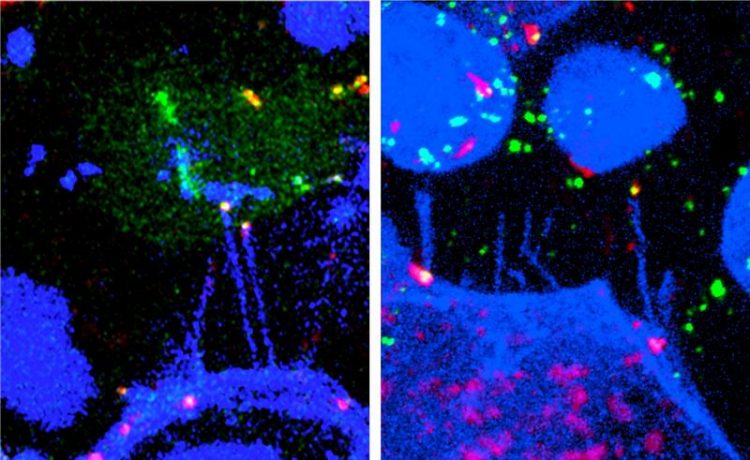How cells communicate

These images show control of cell differentiation in the central nervous system: Long, blue-colored cytoplasmic projections, so-called filopodia, carry the red-colored signaling protein Wnt at the tip. As soon as neighboring cells are activated by the Wnt filopodia, the contact points are colored yellow. Photos: Eliana Stanganello and Steffen Scholpp
During embryonal development of vertebrates, signaling molecules inform each cell at which position it is located. In this way, the cell can develop its special structure and function. For the first time now, researchers of Karlsruhe Institute of Technology (KIT) have shown that these signaling molecules are transmitted in bundles via long filamentary cell projections.
Studies of zebrafish of the scientists of the European Zebrafish Resource Center (EZRC) of KIT revealed how the transport of the signaling molecules influences signaling properties. A publication in the Nature Communications journal presents the results.
Organisms, organs, and tissues are complex three-dimensional systems that consist of thousands of cells of various types. During embryonal development of vertebrates, each cell requires information on the position at which it is located in the tissue.
This position information enables the cell to develop a certain cell type for later execution of the correct function. This information is transmitted via signal molecules, so-called morphogenes. These morphogenes are not homogenously distributed in the tissue, their concentration varies. Various concentrations activate various genes in the target cell.
The cells in the developing central nervous system receive their position information from signal molecules belonging to the family of Wnt proteins. The concentration of Wnt proteins determines whether a cell differentiates to a cell of the forebrain or of the afterbrain. “Distribution of these signal molecules has to be controlled precisely,” Dr. Steffen Scholpp, head of a research group of the KIT Institute of Toxicology and Genetics (ITG), explains. “Smallest changes of the concentration or the transport direction may cause severe damage, such as massive malformations during embryonal development or formation of cancer.”
For the first time now, the working group of Dr. Steffen Scholpp has shown that the Wnt proteins are transmitted specifically via long cell projections, so-called filopodia. In the Nature Communications journal, the scientists report that the signaling factors are loaded on the tips of the filopodia only. In this way, signaling can start immediately upon contacting. The signaling factors bind to the corresponding receptors of the target cell and induce the correct cell response.
“Now, the source cell can decide precisely which target cell receives how much signaling protein at which time,” Scholpp explains. The KIT researchers study zebrafish and human cell lines and succeeded in reproducing or reducing the filopodia and analyzing the resulting changes of signaling properties of the Wnt morphogenes.
###
Eliana Stanganello, Anja I.H. Hagemann, Benjamin Mattes, Claude Sinner, Dana Meyen, Sabrina Weber, Alexander Schug, Erez Raz & Steffen Scholpp: Filopodia-based Wnt transport during vertebrate tissue patterning. Nature Communications, published 5 January 2015. DOI: 10.1038/ncomms6846
About the EZRC
The European Zebrafish Resource Center (EZRC) of KIT accommodates a central archive for the cultivation and distribution of zebrafish stems for research. Zebrafishes are ideal model organisms for studying the causes of cancer or cardiac diseases or the effects of medical substances. Most organ systems of these vertebrates correspond to the organ systems of human beings. Moreover, zebrafish eggs are transparent and develop outside of the mother's body. In this way, the development of organs or even of individual cells can be observed in the embryo or the also transparent larva. The EZRC also is a screening center that offers innovative technologies, such as high-throughput synthesis of medical substances, genome sequencing, robotics and software for sample handling, microscopy, and image analysis.
Media Contact
All latest news from the category: Life Sciences and Chemistry
Articles and reports from the Life Sciences and chemistry area deal with applied and basic research into modern biology, chemistry and human medicine.
Valuable information can be found on a range of life sciences fields including bacteriology, biochemistry, bionics, bioinformatics, biophysics, biotechnology, genetics, geobotany, human biology, marine biology, microbiology, molecular biology, cellular biology, zoology, bioinorganic chemistry, microchemistry and environmental chemistry.
Newest articles

A ‘language’ for ML models to predict nanopore properties
A large number of 2D materials like graphene can have nanopores – small holes formed by missing atoms through which foreign substances can pass. The properties of these nanopores dictate many…

Clinically validated, wearable ultrasound patch
… for continuous blood pressure monitoring. A team of researchers at the University of California San Diego has developed a new and improved wearable ultrasound patch for continuous and noninvasive…

A new puzzle piece for string theory research
Dr. Ksenia Fedosova from the Cluster of Excellence Mathematics Münster, along with an international research team, has proven a conjecture in string theory that physicists had proposed regarding certain equations….



